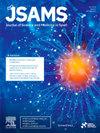Inclusive basketball training for players with intellectual disability
IF 3
2区 医学
Q1 SPORT SCIENCES
引用次数: 0
Abstract
Objectives
To evaluate sport-specific basketball skills before and after 8 months of integrated and non-integrated basketball practice of participants with intellectual disability; in relation to the competitive basketball level and the degree of intellectual disability.
Design
Pre-test/training/post-test design.
Methods
Forty-one adult male players with intellectual disability were randomly divided into 21 athletes playing in the Integrated Basketball group together with 10 athletes without intellectual disability, and 20 athletes playing in the Non-integrated Basketball group. All players were assessed through pre and post basketball skill tests for assessing four levels of ability of increasing difficulty (levels I, II, III, and IV), each one characterized by the fundamental skills of the basketball game: ball handling, passing, receiving, and shooting. The athlete’s global score based on the total score of all levels of ability was calculated for each player.
Results
Passing, receiving, shooting, ball handling, global, level I, and level II scores improved after the intervention independently by integrated basketball or non-integrated basketball. Post−pre (∆) scores in ball handling, receiving, passing, shooting, global, level I, and level II showed that the athletes in the Integrated Basketball group improved significantly more than athletes in the Non-integrated Basketball group. Ball handling, receiving, passing, shooting, global, level I, level II, and level III scores were negatively correlated with intellectual disability level.
Conclusions
Athletes with intellectual disability who performed both integrated basketball and non-integrated basketball improved significantly their basketball skills after an 8-month training. However, the athletes training in the Integrated Basketball group obtained the best scores.
为智障运动员提供包容性篮球训练。
目的评估智障参与者在8个月的综合和非综合篮球训练前后的特定运动篮球技能;与篮球竞技水平和智障程度有关:设计:前测/训练/后测设计:方法:41 名成年男性智障运动员被随机分为 21 名综合篮球组运动员和 10 名非智障运动员,以及 20 名非综合篮球组运动员。所有运动员都接受了篮球技能测试前后的评估,以评估难度递增的四个能力等级(I 级、II 级、III 级和 IV 级),每个等级的特点都是篮球比赛的基本技能:控球、传球、接球和投篮。根据所有能力水平的总分计算出每位运动员的综合得分:结果:综合篮球和非综合篮球干预后,传球、接球、投篮、控球、总分、一级和二级得分均有提高。综合篮球组运动员在控球、接球、传球、投篮、全局、I 级和 II 级方面的干预后得分(∆)显示,综合篮球组运动员的进步明显高于非综合篮球组运动员。控球、接球、传球、投篮、综合、一级、二级和三级得分与智障程度呈负相关:综合篮球组和非综合篮球组的智障运动员在经过 8 个月的训练后,篮球技能都有明显提高。然而,综合篮球组的运动员得分最高。
本文章由计算机程序翻译,如有差异,请以英文原文为准。
求助全文
约1分钟内获得全文
求助全文
来源期刊
CiteScore
7.40
自引率
10.00%
发文量
198
审稿时长
48 days
期刊介绍:
The Journal of Science and Medicine in Sport is the official journal of Sports Medicine Australia (SMA) and is an an international refereed research publication covering all aspects of sport science and medicine.
The Journal considers for publication Original research and Review papers in the sub-disciplines relating generally to the broad sports medicine and sports science fields: sports medicine, sports injury (including injury epidemiology and injury prevention), physiotherapy, podiatry, physical activity and health, sports science, biomechanics, exercise physiology, motor control and learning, sport and exercise psychology, sports nutrition, public health (as relevant to sport and exercise), and rehabilitation and injury management. Manuscripts with an interdisciplinary perspective with specific applications to sport and exercise and its interaction with health will also be considered.

 求助内容:
求助内容: 应助结果提醒方式:
应助结果提醒方式:


